The Beatles performed two sold-out shows there. Boxing legend Muhammad Ali defeated Floyd Patterson there. Led Zeppelin was supposed to wrap up its 1970 North American tour there (they had to cancel after lead singer Robert Plant fell ill).
The Las Vegas Convention Center (LVCC), which opened in 1959, certainly has been an integral part of Sin City’s history — and, up until a couple years ago, really looked straight out of history, too. With its exterior aluminum-paneled siding in a factory-finish mauve-pink hue — the “period” color of the era — the LVCC really was beginning to show its age and was very much in need of a makeover.
Techno Coatings Inc. won the bid to give the third-largest convention center in the United States a new coat of paint — and luck had nothing to do with it. At the time of the project, nearly four years ago, the Anaheim, California-based firm had been rated by the Engineering News Record as the top third painting contractor in the nation (and it is still among the top five) and has other notable projects under its belt, including jobs at Disneyland and Alcatraz. It was a winning combo.
Before Techno Coatings could get started, though, the project itself needed to get the seal of approval from the Las Vegas Convention and Visitors Authority (LVCVA). And how do you make your case in Vegas? Why put on a show, of course.
Oscar Goodman, then-mayor of Las Vegas, strolled into the town hall meeting with two showgirls dressed in elaborate costumes — feathers and all — to make his pitch to the board about how much money the city could lose if they did not modernize the LVCC and make it a world-class convention destination. Bruce Birney, president and CEO of Techno Coatings, who witnessed the spectacle himself, said the pageantry worked like a charm.
One request LVCVA did make when giving the project the green light was for Techno Coatings to hire journeyman painters from the Las Vegas District Council 15. That suited Techno Coatings just fine; one of its former employees had moved to Vegas and was able to recruit the top talent to join the 15-member crew to paint the convention center’s approximately 300,000-square-foot (27,870.9 m2) exterior.
It seems like a pretty straightforward project, right? Wrong.
“Paint by Numbers” Design
Enter the architect who created a two-toned gray “block look” for the building and an accompanying schematic detailing exactly which of the 2 1/2-foot-high (0.8 m) by 10-foot-long (3.1 m) panels needed to be painted a lighter gray and which ones needed to be a darker gray. The thing was, there seemed to be no rhyme or reason to the architect’s plan — it was more like a “paint by numbers” design that the crew needed to adhere to.
Figuring out which panels would get the lighter gray paint vs. the darker turned out to be quite laborious. There was a lot of checking and rechecking of the drawings. In the end, the team discovered they could get a good rhythm going by applying one color first and then going back and doing the other color.
Sun Protection
Techno Coatings opted to go with a paint and primer from Tnemec because of its resistance to ultraviolet (UV) rays and winds — a must for a building exposed to the harsh Vegas sun and strong desert winds, said project manager Chuck Whitehead.
Specifically, Techno Coatings used Tnemec’s Chembuild Series 135, “a high-build coating with superior wetting for marginally prepared rusty steel and tightly adhering old coatings,” for the primer, according to Tnemec’s fact sheet. That primer was applied at 3 to 5 mils (76.2‒127.0 microns) dry film thickness (DFT). The crew applied the finish coat at 2 to 3 mils (50.8‒127.0 microns) DFT. That was Tnemec’s Fluoronar 1072, a high-solids fluoropolymer coating that “has outstanding color and gloss retention even in the most severe exposures,” also according to Tnemec’s fact sheet.

Whitehead was not on the site every day but did make the occasional trip from Anaheim to check on the work and give guidance as to how the coatings should be applied — by not using too heavy of a hand or applying it too thickly, a costly mistake that’s easy to make if you are not consciously thinking about it, he said. With both the primer and finish coat costing a small fortune — $400 and $500 per gallon, respectively — he had to be conscious about waste.
In total, 600 gallons (2,271.3 L) of Chembuild primer and 500 gallons (1,892.7 L) of Fluoronar were used — so nearly half a million was spent just on coating products.
Getting Down to Work
Up on boom lifts that could stretch up 85 feet (25.9 m) high, the 3- to 15-person crew members went about their work employing a brush-and-roll method using Purdy brushes and PosiTector 6000 coating thickness gages from DeFelsko. In certain areas, Graco Silver airless spray guns also were utilized, which were distributed by Paint Sprayers Unlimited.
To ensure their safety, the team wore safety harnesses and belts. Because the work was outdoors, face respirators were optional.
The panels were separated with a 1-inch (2.5 cm) black flexible rubber joint, so great care needed to be taken to prevent paint from getting onto the gaskets.
One constant challenge the crew encountered: to continue working while large conventions were moving in and out. The convention center stayed open the entire duration of the project, so it required a lot of coordination to maneuver around the legions of attendees, workers, equipment, and traffic from the conventions.
Desert wind was also a constant threat, but in the end it had minimal impact. The hot temperatures, which climbed up to 112° F (44.4° C), did prove to be quite bothersome. First, the substrate would heat up to well over 100° F (37.8° C), which is not suitable for application. Then, sun also would beat down on the painters, threatening heat exhaustion. To combat this, the men worked in two shifts — early mornings and evenings — to avoid being under the full intensity of the sun.
Ultimately, it all worked out well. Techno Coatings wrapped up in half the projected time, completing the job in three months instead of six, and the company has another iconic site to add to its portfolio. In fact, Techno Coatings is so proud of its work on the LVCC, that it has included the now-modern-looking building in its 2017 calendar.
